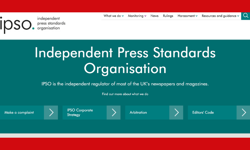Ah yes, - strategy. All organisations purport to have one. Some several. Many individuals claim personal ones to help bring order and direction to their lives. Most are characterised by their boldness and aspirational language. “We have a totally new strategy… it’s very, very internationally focused and we’re looking to develop the brand to the next level.” Any ideas? A major multinational, a Diageo or Glaxo perhaps. Or an airline operator, or maybe even a fashion house? No. It’s a quote from a spokeswoman for Katie Price (aka Jordan) speaking to the Daily Mirror back in 2009. Top marks for ambition, but what on earth does it mean?
Or how about this one: [big breath] “A principle component of our strategic plan is to restore the financial health and profitability of the company. We believe that fiscal 2010 will continue to be challenging for retailers due to continued uncertainty in the economic environment, and as a consequence we will maintain our focus on maximising cash flow, reducing debt, conserving capital, tightly managing expenses and improving profitability. In addition, we will continue to reduce working capital needs by further driving inventory productivity, thus improving cash flow and lowering supply chain costs.” Sounds familiar perhaps. Change just a few words, and this could apply to many UK publishing businesses, as they continue to grapple with a stuttering economy and structural industry change. It’s actually an extract from Borders (Books) US business annual report for 2009. It’s full of blindingly obvious (and no doubt necessary) survival language, but has no linkage to what it was intending to do for its customer growth or the impact of that on its finances. Borders filed for Chapter 11 Bankruptcy protection nine months later.
And then there’s strategy by another name. Where does strategy end and tactics take over? Or a strategic aim dilute down to one of several goals? And then, heaven forbid, there’s the Mission and Vision thing to contend with - or is it Purpose? Is that the strategy, by another name? It’s a word-cloud creator’s dream, and can be utterly bewildering, to say the least. And the confusion is fuelled, day in day out, in many businesses by the eagerness of management to talk in pseudo-strategic language. At best, it’s carelessness from people who should know better (hopefully) and at worst, it’s damaging and debilitating to the organisation as people try and work out what matters and what doesn’t. And the value of strategic clarity is as much about helping people understand what not to do, as it is about the must-dos. At a time of yet further cost-elimination for many publishers, particularly those in the regional media sector, clear strategic direction defines which costs matter and those which don’t. Or so you hope.
Many text books (and strategy has had more written about it than nearly any other business subject) major in defining strategy in relation to the military origins of the word. For me, that bears little relevance these days, other than satisfying the desires of certain managers to harness their troops, go over the top, win the war and claim the spoils of victory. Modern businesses are not waging military campaigns, by and large. But media companies do seem more inclined than most to debate one another’s strategies – or more correctly, perceived strategies: web migration, hyperlocal publishing, apps, paywalls, e-readers. On it goes. How many of these are truly strategic imperatives is questionable.
So what’s going on? Simply, strategy is one of the most used yet least understood words in business. As a consequence, its constant usage can have a damaging effect on the whole organisation.
Ask each of the most senior executives in many businesses what their strategy is, and they’ll tell you. If you’re incredibly lucky, two of them may be vaguely similar. The majority will be utterly different (but no doubt very worthy and in their own way important to the business). Go down a tier in the company’s management, and chances are they will all be different. Go down one more, and they won’t know what you’re on about. Sound familiar? Why not try it - walk down the corridor next to you and ask some questions.
In my experience, business is best kept simple. Very simple. Each organisation should know its purpose and mission and that should be supported by a clear strategy statement. The strategy statement is simply how the mission will be achieved. Job done.
But how can it be that so much confusion and lack of clarity exists in so many businesses, when it is such a fundamentally important principle and inherently very straightforward?
The sad truth is that most strategies simply don’t play out in any meaningful way, despite their apparent existence within boardrooms, management briefings, annual reports, etc. And in there lies much of the problem. Strategy reviews are so often conducted by a few superior beings, hidden away from the prying eyes of the masses. Some will share their conclusions, other won’t. But in all cases, the task of implementing the strategic requirements will invariably be relegated down the organisation, but often not badged as such.
But does it really matter? After all, Richard Branson in his book Business Stripped Bare says he never had a strategy when he was founding the Virgin Group. No doubt true in nomenclature terms, but what he did have was vision, razor sharp clarity and a wonderful capacity to share and achieve buy-in. To my mind, he had a fantastic strategy.
I passionately believe that every business must have a single, definable, measurable and shareable objective. The one thing, above all else, which must be done in order to achieve success. But, in the absence of Richard Branson qualities, how do you get there? I offer up a Top 10 Guide for achieving strategic clarity and why you must do it:
1. Engage
Publishing businesses have so many touchpoints with customers and potential customers. Use them. Talk to people right across the business. Involve them in the process and let them feed your thinking. It is these guys who will be implementing and delivering on your strategic plan.
2. Use Your Values
Ensure your strategy sits comfortably with what you have established as core values in the business. Staff will see through it if you don’t.
3. Spell It Out
If you don’t define a simple, easily understood strategy, your staff will assume their own. And there’ll be lots of them. Some will be ok, others won’t. And you will know about some and not others. Collectively, they’ll begin working against each other, confusing and obstructing. In determining your strategy, concentrate on what defines you in the marketplace. Is it price, product, service? How are you or how do you want to be different to your competitors? There are three very powerful questions to keep asking of yourselves:
* What does ‘great’ look like?
* What if…?
* What makes us different?
4. Keep it simple
Be able to write down your core strategy in under 35 words. Tough, but achievable. Any more than that and your staff will start to lose it.
5. Cascade
The people in your organisation are probably smarter than you generally give them credit for. By communicating and cascading your strategic objectives, you’ll achieve understanding, consistency, common-purpose and ultimately, buy-in. Bear in mind the challenge as strategy cascades from head office to a divisional unit, to a branch or satellite or overseas operation and so on. Staff will always tend to interpret strategy within the context of their own environment and their own role in the organisation. What hits the target within a big operating division may be a mile off to the ten staff working in Scotland!
6. Teaming
Strategic clarity is the connective tissue which joins everyone in the organisation together. It is a bedrock of both quality teaming and high performing cultures. And high performing cultures, in a strategic sense, is a point of great differentiation and value.
7. Agility
The route from A to B is seldom linear. Recognise the importance of being agile and changing direction speedily, in order to deliver on your strategic requirement.
8. Remember the customer
Obvious, but so often lacking. It’s why you are in business. Relentless cost cutting may be a requirement, but your strategy should act as a protector of value – customer as well as shareholder. All too often, blunt and poorly thought-through cost-cutting forgets the primary needs of customers.
9. Execute Brilliantly
Don’t allow anything to get in the way of executing and following-through on your strategic plans. Nothing in the organisation should take precedence. Talk about it first and last.
10. Permanent Review
Strategic planning is an un-ending task and should be subject to permanent, rather than occasional or even monthly, review. “We do our strategic and business planning every September”, for example, is a bizarre notion and yet not uncommon. It is difficult to imagine a single meeting within the business, at whatever level and within whatever department, at which the core strategy shouldn’t be present, either in giving direction or providing a point of reference or challenge. But you have to invite it! You have to know it exists. Permanent review is a strategic strength, not a weakness, even if it requires a re-shaping of your previously, finely crafted work, in order to achieve the desired results.
So there we are. The value of strategic clarity in two pages. Of course this is a highly simplified piece about a challenging, demanding and time-hungry subject. But I invite you to look at your own organisation and your own experiences and judge whether your organisation is achieving its true potential. And if not, I encourage you to start or revisit the strategic journey and reap the rewards.
Finally, I’ve found myself almost incapable of finishing this piece without a classic, text book definition of the word strategy. But I’ve managed it. Instead, one of my favourite Winston Churchill quotations: “however beautiful the strategy, you should occasionally look at the results”. Something for all of us, Katie Price included, to perhaps ponder on.










